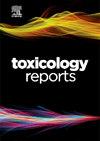伊真火山口火山的有毒自然污染:环境特征和健康风险评价。
Q1 Environmental Science
引用次数: 0
摘要
伊真火山口火山(ICV)是我国环境条件独特的活火山之一;它是世界上最大的湖泊,具有最极端的酸度和蓝色火焰现象,并释放有毒的火山气体,包括危险的二氧化硫(so2)。它对环境和生态系统有影响。本研究旨在探讨蓝火现象和有毒气体SO2,表征ICV的环境条件和健康影响。在这项研究中使用的方法是在仁济火山口火山周围的32点采样中使用撞击器进行二氧化硫浓度测量。环境特征是基于自我观察,站观察,访谈和可靠的文献资料。健康影响是根据当地和全球法规的阈值来测量的。研究表明,ICV的特征包括深度达200 m,直径为± 900 m, pH值小于1的火山口湖。SO2的来源是岩浆与火山气体的反应。蓝火现象,在某些情况下发生,经常增加了ICV的自然奇观。SO2浓度分布范围为480 ~ 6960 ppb。接下来,几乎是危险报价(HQ) > 1每一点抽样。这意味着SO2浓度和HQ都超过了影响人类活动的阈值。本文章由计算机程序翻译,如有差异,请以英文原文为准。
Toxic natural pollution at Ijen crater volcano: Environmental characteristics and health risk assessment
The Ijen crater volcano (ICV) is one of the active volcanoes with unique environmental conditions; it is the largest lake in the world with the most extreme acidity and a blue fire phenomenon and releases toxic volcanic gases, including dangerous sulfur dioxide (SO₂). It has an impact on the environment and ecosystem. This research aimed to investigate the blue fire phenomena and toxic gas SO2 and characterize the environmental conditions and health effects of the ICV. The method used in this research involved carrying out an SO2 concentration using an impinger in 32-point sampling around the Inje crater volcano. The environment was characterized based on self-observation, station observation, interviews, and reliable literature data. The health effect was measured based on the threshold level value based on local and global regulations. This research shows that the characteristics of the ICV include a crater lake with a depth of up to 200 m and a diameter of ± 900 m with pH values less than 1. Then, the source of SO2 comes from the reaction of magma with volcanic gas. the blue fire phenomenon, which occurs in certain situations, frequently adds to the natural wonder of the ICV. In addition, the distribution of SO2 concentrations ranges from 480 to 6960 ppb. Next, almost the Hazard Quotion (HQ) > 1 every point sampling. This means that the SO2 concentration and HQ exceed the threshold value affecting human activities.
求助全文
通过发布文献求助,成功后即可免费获取论文全文。
去求助
来源期刊

Toxicology Reports
Environmental Science-Health, Toxicology and Mutagenesis
CiteScore
7.60
自引率
0.00%
发文量
228
审稿时长
11 weeks
 求助内容:
求助内容: 应助结果提醒方式:
应助结果提醒方式:


